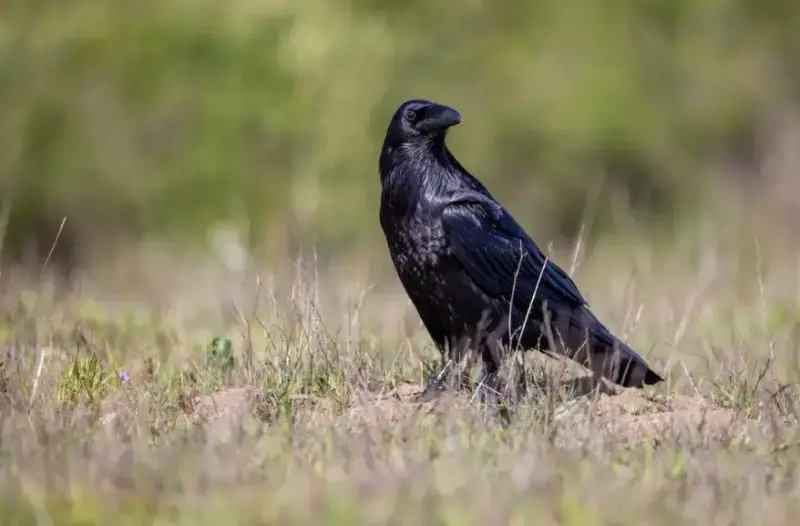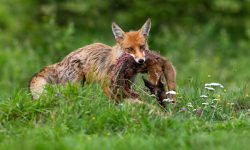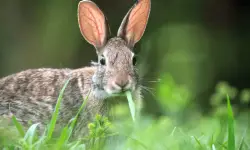Crows are some of the most intelligent and adaptable birds on Earth. Found across nearly every continent, these glossy black creatures are known for their sharp minds, problem-solving skills, and complex social behavior. They’ve learned to survive—and thrive—in both wild and urban environments, adapting their feeding habits to whatever resources are available.
But one question often comes up: What do crows eat? Their diet is as versatile as their behavior. Crows are omnivores, which means they eat both plant and animal matter. From insects and fruits to small mammals and human leftovers, their ability to eat almost anything makes them one of nature’s most successful survivors.
In this detailed guide, we’ll explore 15 foods crows love the most, how their diet changes with the seasons, and what their eating habits reveal about their intelligence and role in nature.
Understanding the Crow’s Diet

Crows belong to the Corvidae family, which also includes ravens, magpies, and jays—birds known for their intelligence. Their omnivorous diet gives them a competitive edge over more specialized species.
They have strong beaks capable of tearing flesh, cracking nuts, and picking apart almost any kind of food. This adaptability has allowed them to thrive in rural fields, dense forests, coastal areas, and even bustling cities.
Crows are also opportunistic feeders, meaning they eat what’s most easily available. This includes hunting small animals, scavenging carrion, and raiding garbage cans. Their diet can vary widely by location, season, and human activity.
15 Foods Crows Love the Most
1. Insects
Insects form a major part of a crow’s diet, especially during spring and summer. They hunt beetles, grasshoppers, crickets, caterpillars, and flies using sharp eyesight and quick movements.
Insects are high in protein and easy to find in agricultural fields and woodlands. Crows also dig into soil or turn over leaves to uncover hidden bugs and larvae.
2. Worms
Worms are another protein-rich food that crows love. After rain, they’re often seen pecking at lawns and fields to pull up earthworms from the soft ground.
Worms provide hydration as well as nutrition. They’re particularly valuable during nesting season when parent crows feed their chicks soft, easily digestible foods.
3. Fruits
Crows have a sweet side, too. They enjoy fruits such as apples, pears, cherries, and berries. Fruits supply vitamins, minerals, and hydration, making them a healthy energy source.
In orchards, crows sometimes become pests, feeding on ripe fruit before harvest. However, their fruit-eating habits also help with seed dispersal, promoting forest regeneration.
4. Nuts and Seeds
Nuts and seeds are essential foods for crows, especially during autumn and winter. They eat acorns, walnuts, sunflower seeds, and grains—either directly from trees or scavenged from the ground.
Crows are famous for storing (or “caching”) nuts in the ground to eat later, showing remarkable memory and foresight. They even use cars to crack open tough nuts by placing them on roads and waiting for vehicles to do the work.
5. Small Mammals
Crows occasionally hunt small mammals like mice, voles, and young rabbits. Although not skilled predators like hawks, they’re clever opportunists who take advantage of vulnerable or injured prey.
These mammals provide high-quality protein and fats, crucial during breeding seasons when energy demands are highest.
6. Eggs and Nestlings
Crows are notorious for raiding the nests of other birds to eat eggs and hatchlings. It’s a natural behavior that helps sustain them when other foods are scarce.
They target species like pigeons, sparrows, and smaller songbirds, carefully cracking open eggs or carrying them away. Though controversial, this behavior plays a role in regulating bird populations.
7. Carrion
Crows are scavengers by nature and readily eat carrion—dead animals found along roadsides or in fields. Their strong beaks tear flesh easily, and their keen eyesight helps them locate carcasses from afar.
By feeding on carrion, crows serve an important ecological role, helping clean the environment and reduce disease spread.
8. Fish
Crows that live near rivers, lakes, or coastal regions often eat fish. They may catch small fish themselves or scavenge leftovers from larger predators.
Some crows have been observed stealing fish from fishing nets or even learning to drop pebbles in water to lure prey closer—a testament to their intelligence and adaptability.
9. Frogs and Amphibians
Amphibians such as frogs, toads, and salamanders are another source of protein for crows. They catch them in wetlands or after heavy rain.
These creatures provide moisture and nutrients and are especially important for young crows learning to hunt.
10. Grains and Crops
Crows commonly feed on grains such as corn, wheat, barley, and rice. While this behavior frustrates farmers, these foods are a natural part of their diet.
Their powerful beaks allow them to strip husks and eat kernels easily. Crows’ fondness for grains explains their frequent presence in farmlands and open fields.
11. Vegetables
In addition to grains, crows eat vegetables like corn cobs, potatoes, and beans. They forage in gardens or farms for easy meals.
While they don’t rely heavily on vegetables, they add variety and fiber to the diet, supporting digestion and overall health.
12. Garbage and Human Food
Crows living in cities have adapted perfectly to urban life. They scavenge trash bins, parking lots, and outdoor eateries for discarded food.
Leftovers such as bread, chips, meat scraps, and pet food are common urban meals. This opportunistic feeding behavior helps them survive even in human-dominated landscapes.
13. Snails and Shellfish
Crows near coastal areas feed on snails, crabs, and shellfish. They’ve been observed dropping hard shells onto rocks or roads to break them open and access the soft meat inside.
This tool-like behavior demonstrates their remarkable intelligence and learning ability—traits that set them apart from most birds.
14. Reptiles
Small reptiles such as lizards or young snakes occasionally fall prey to crows. Though not a primary food source, these add diversity to their diet.
Reptiles provide concentrated nutrients and are easy to catch when basking or moving slowly on warm days.
15. Pet Food
In suburban areas, crows often raid outdoor pet bowls for dog or cat food. These kibbles are high in protein and fats, making them ideal for active birds.
Their memory allows them to return to the same houses or yards where they previously found food, showing advanced spatial awareness.
Seasonal Changes in a Crow’s Diet
Crows’ diets vary depending on the time of year and the resources available:
- Spring: Insects, worms, and nesting materials are abundant. They eat protein-rich foods to prepare for breeding season.
- Summer: Fruits, vegetables, and small animals dominate. Crows feed their young soft foods like worms and fruit.
- Autumn: Nuts, seeds, and grains are gathered and stored for winter. Crows become more visible in open fields.
- Winter: Crows rely on stored nuts, carrion, and human waste when natural food is scarce. Their adaptability shines during this season.
Nutritional Breakdown of a Crow’s Diet
Crows need a balanced diet to stay strong and maintain their glossy feathers:
- Protein: Found in insects, eggs, meat, and carrion. Essential for muscle development and reproduction.
- Fats: Gained from nuts and small animals, providing energy and warmth in cold climates.
- Carbohydrates: From grains and fruits, sustaining daily activity and flight energy.
- Vitamins & Minerals: Supplied by plants, seeds, and berries for immunity and healthy plumage.
Their flexible eating habits ensure they get all the nutrients needed for survival.
How Crows Hunt and Forage
Crows use intelligence and teamwork to find food. They often forage in groups, with individuals taking turns as lookouts while others feed.
They use their beaks and feet to turn over leaves, dig soil, or open containers. Urban crows have been observed using tools—like sticks or even passing traffic—to access food.
Crows also cache surplus food, hiding it under leaves, grass, or snow to retrieve later. Their memory is exceptional; they can recall dozens of food storage spots for weeks.
The Role of Crows in Ecosystems
Crows play a crucial role in maintaining ecosystem balance.
- As scavengers, they clean up carrion and organic waste, reducing disease spread.
- As seed dispersers, they aid forest regeneration through fruit consumption.
- As pest controllers, they keep insect and rodent populations in check.
Although they sometimes clash with humans, crows are vital contributors to healthy environments.
Crows and Human Interaction
Crows are highly intelligent and learn quickly to associate humans with food. In some areas, they even recognize individual human faces—rewarding friendly behavior and avoiding threats.
People have reported crows bringing “gifts,” such as shiny objects or small trinkets, to those who feed them regularly. However, feeding wild crows should be done responsibly with natural, healthy foods like unsalted nuts, fruits, and grains.
FAQs About Crow Diets
What do crows eat the most?
Crows primarily eat insects, fruits, grains, and small animals, depending on what’s available.
Do crows eat meat?
Yes. Crows eat small mammals, carrion, and occasionally other birds’ eggs or chicks.
Do crows eat fruit?
Absolutely. They love fruits like apples, cherries, and berries for natural sugars and vitamins.
What do crows eat in winter?
They rely on stored nuts, carrion, grains, and human leftovers during the colder months.
Do crows eat garbage?
Yes, especially in cities. They scavenge trash for meat scraps, bread, and pet food.
Can I feed crows?
Yes, but offer natural foods—unsalted nuts, fruits, and seeds—to avoid health issues from processed snacks.
Conclusion
Crows are remarkable survivors with one of the most flexible diets in the animal kingdom. From insects and fruits to carrion and grains, these resourceful birds eat whatever nature—or humans—provide. Their adaptability, intelligence, and social cooperation make them successful in both wild and urban settings.
Understanding what crows eat gives us insight into how they shape and sustain ecosystems. They clean up waste, disperse seeds, and control pests, proving that even the most common birds play extraordinary roles in the natural world.
So next time you see a crow foraging in a field or picking through a park, remember—it’s not just scavenging. It’s demonstrating one of nature’s smartest feeding strategies, fine-tuned for survival and success.






